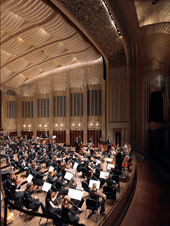About the Oberlin Orchestra

The Oberlin Orchestra performing at Severance Hall, home of the Cleveland Orchestra
Photo by Roger Mastroianni
The Oberlin Orchestra has enjoyed a rich history of notable guest conductors including Igor Stravinsky, Pierre Boulez, Sir Simon Rattle (whose son is an Oberlin alumnus), David Zinman, Robert Spano, and John Williams. Recent appearances by the Oberlin Orchestra include performances at Walt Disney Concert Hall in Los Angeles; at Cleveland’s Severance Hall, home of the Cleveland Orchestra; a 13-day tour of China in 2005; and a critically acclaimed performance at Carnegie Hall in New York conducted by Robert Spano. The New York Times described the performance at Carnegie Hall as “stellar.”
After Sir Simon Rattle conducted the Oberlin Chamber Orchestra in December 2004, Plain Dealer music critic Donald Rosenberg wrote that the concert was “stamped by magnificence.” Indeed, Rosenberg included the Oberlin-Rattle performance of Mahler’s Symphony No. 4, which he described as “uncommonly rich in poetry and drama,” in his list of top 10 memorable events from the 2004 concert season.
The Oberlin Conservatory of Music, awarded the highest artistic honor in the United States, the National Medal of Arts, by President Obama in February 2010 is known the world over as an institution of exceptional excellence. Praised as a “National treasure” by the Washington Post, Conservatory graduates have achieved prominence as solo performers; chamber, orchestral, and jazz musicians; composers; conductors; music educators and scholars; and are found in all major orchestras and opera companies around the world. In 2009, the Conservatory produced the Grammy nominated recording Air, and this year opened the finest jazz studies facility in the world with guest artist Stevie Wonder.
A Brief History
Back in 1896, very few people were violin or cello majors, and no one majored in any of the wind instruments. Professors Fred and Charles Doolittle taught violin and cello; Professor J. Arthur Demuth taught violin, cornet, horn, trombone, oboe, and clarinet; and Charles Doolittle, taught flute. Their valiant efforts made possible the formation that year of a Conservatory Orchestra with Professor George W. Andrews as conductor.
In 1916 the string and wind instrument students at the Oberlin Conservatory of Music were a small group. The addition of instructors Maurice Kessler, violinist from the Boston Symphony, and Friedrich Goerner, former first cellist with the Pittsburgh Symphony, had strengthened the department, but of the 13 students studying with Mr. Goerner, only one was a cello major.
At this time the Conservatory Orchestra under Professor Andrews included 40 musicians and consisted of one flute, one clarinet, two trumpets, three horns, trombone, timpani, and strings. Until the 1930s the missing parts would be supplied by organist Bruce Davis, who through long experience and great ability had acquired an enormous deftness in this task. Willard Warch was a member of the Orchestra's cello section 1927-31. In his history of the Oberlin Conservatory of Music, Our First 100 Years, from which this account is taken, he recalls looking out over the orchestra at a typical rehearsal and saying, "Bruce! Today we need second flute, second oboe, both bassoons, and third and fourth horns." And that, wrote Warch, is what he gave them, or at least the essentials.
In the years before the 1950s, the orchestra also had the assistance of other faculty members. Arthur Heacox had studied string bass in Munich and Paris and served the orchestra faithfully as bassist—sometimes the only one—for years. When he retired, he persuaded Don Morrison, of violin and music education, to be his successor. Victor Lytle of the theory department was the orchestra timpanist for several years. Professor Andrews himself, while a student in the 1870s, had learned trombone in order to help the orchestra of that time.
Demuth, in 1916, played some of the winds or strings, as did his successor of the 1920s, R. Walter Frederick. The violin and cello teachers, of course, filled the first chairs of their instruments, and even the College faculty helped. Jameson played horn. Professor and Mrs. Wolfgang Stechow played viola, and Dean Carl F. Wittke of the College of Arts and Sciences first played viola and then string bass. When Arthur Williams came in 1928, he played horn on occasion as well as trumpet. Yet the outstanding record of assistance to the Oberlin Orchestra and Bands belongs to George Waln, who, at one time or another, played B-flat clarinet, E-flat soprano clarinet, alto clarinet, bass clarinet, flute, English horn, bassoon, and contrabassoon.
A notable professor of orchestral conducting from 1966 to 1983 was Robert Baustian. The pantheon of conductors on the classical music scene who trained at Oberlin includes David Zinman '58, Robert Spano '83, Raymond Harvey '73, Michael Morgan '73, Jeannette Sorrell '92, Edwin London '52, John Kennedy '82, David Hoose '69, Stephen Gunzenhauser '63, and Michael Christie '96.
Selected source material from Our First 100 Years by Willard Warch.
Musicians
- Timothy Weiss, conductor
- Lee-Chin Siow '95, violinist
- Meet the Oberlin Orchestra
- About the Oberlin Orchestra
Downloads

The Oberlin Orchestra performing at Severance Hall, home of The Cleveland Orchestra
Photo Credit: Roger Mastroianni
Download High Resolution Image (ZIP)
About the Oberlin Orchestra (PDF)
Brief History of Oberlin Orchestra (PDF)
Home Towns of Orchestra Members (PDF)
High Resolution Images of Orchestra Members (Picasa Album)
© 2010 Oberlin College & Conservatory
